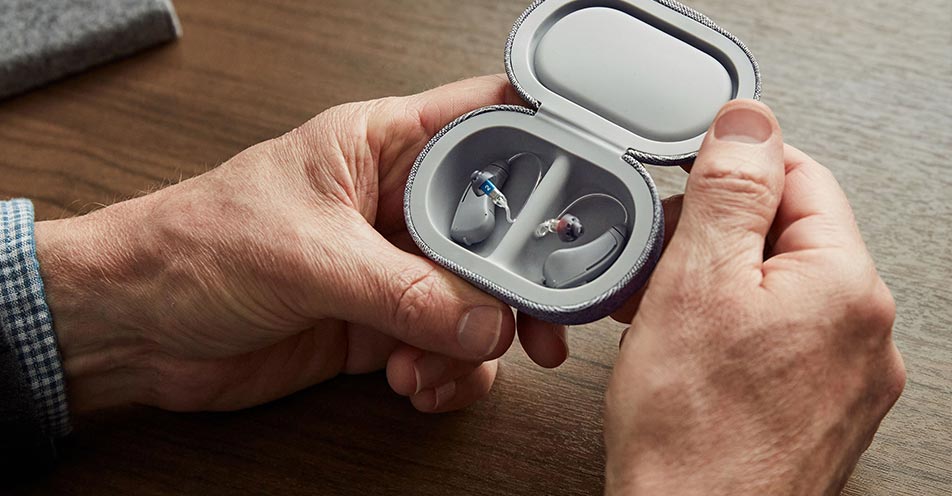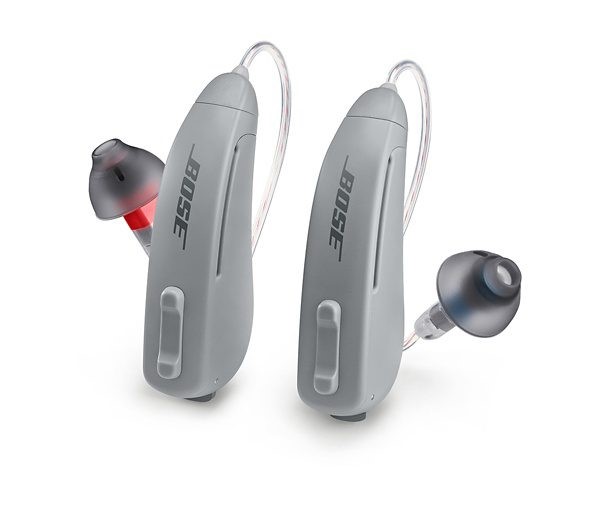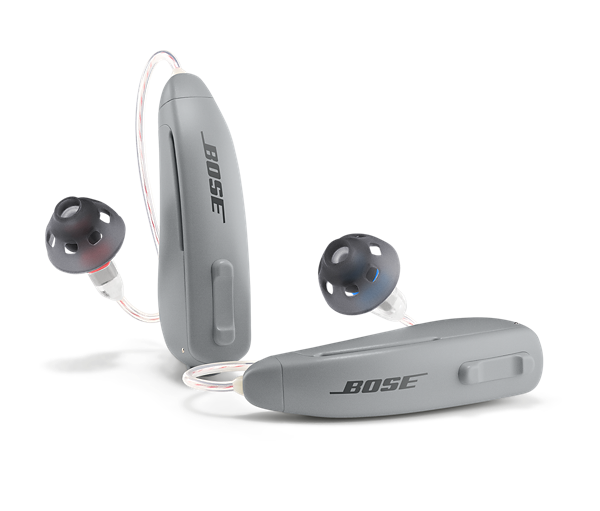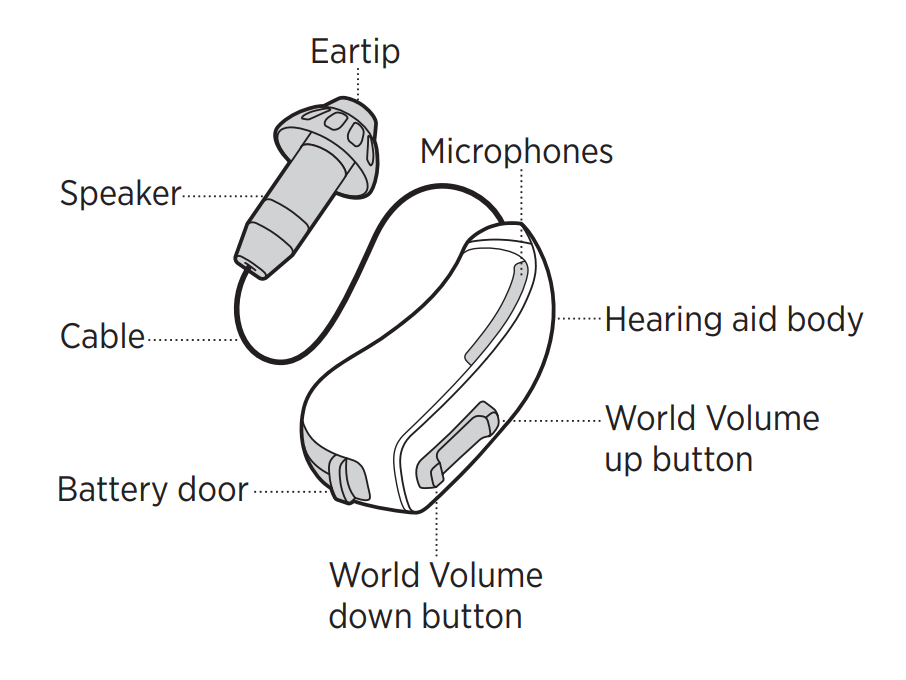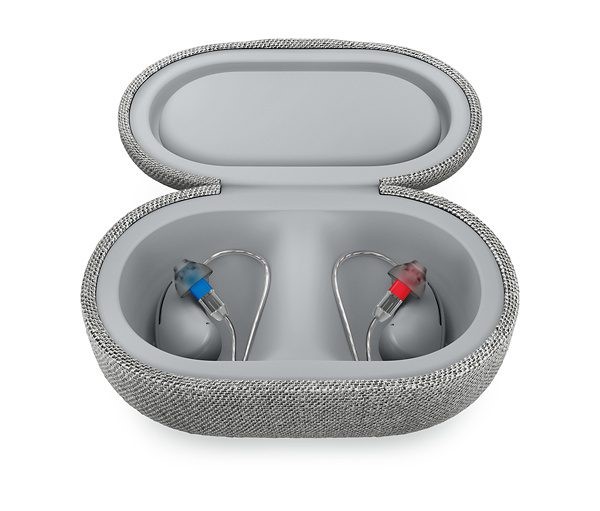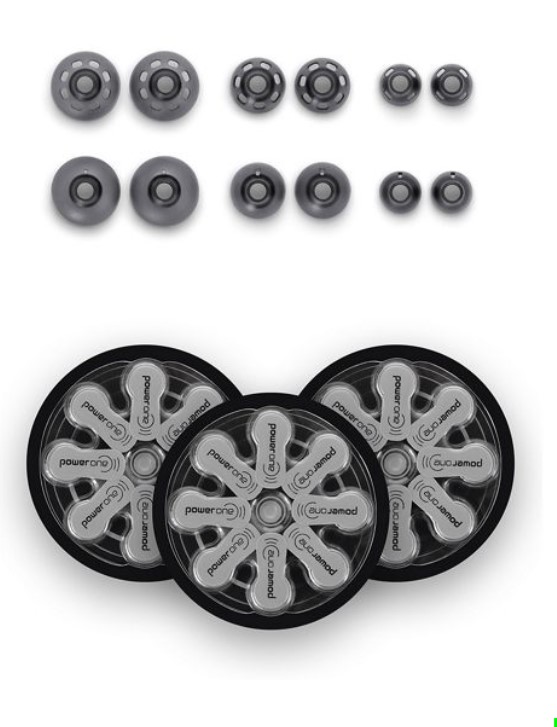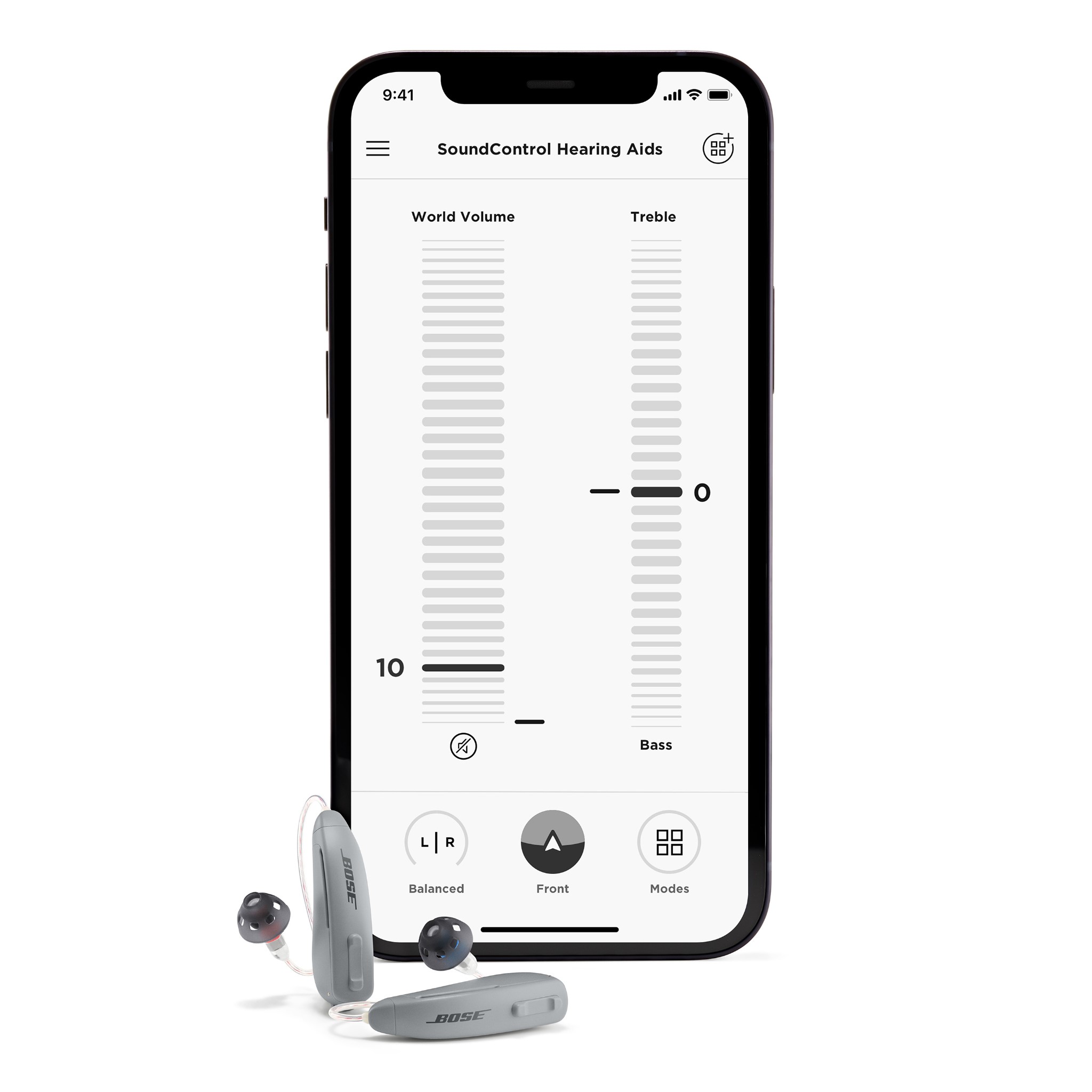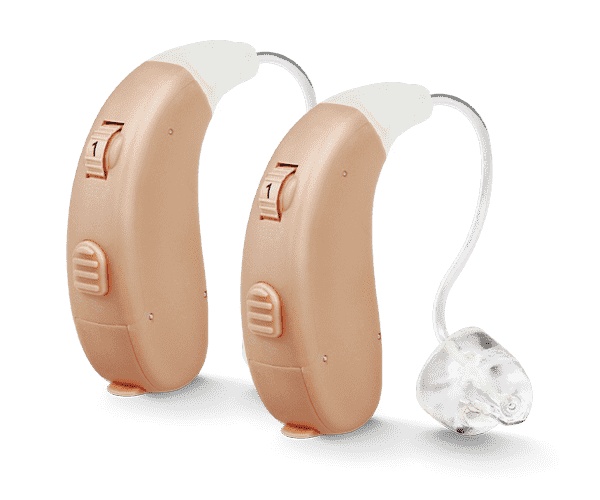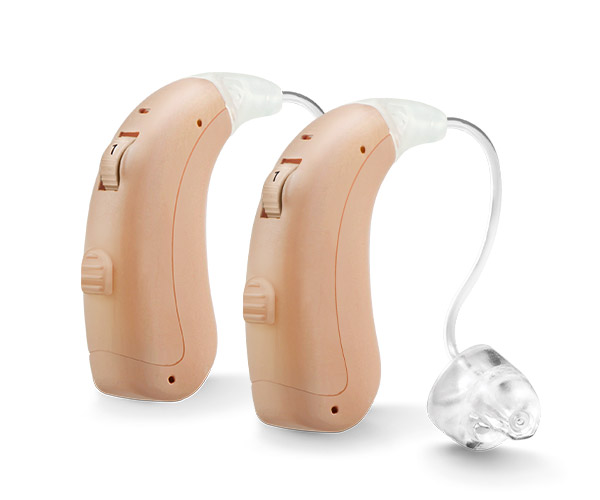The “Big Six” hearing aid manufacturers have dominated 98 percent of the global hearing aid market for decades. These manufacturers offer dozens of hearing aid options, but these hearing aids usually cost thousands of dollars a pair – a price tag that’s absolutely unaffordable for many consumers.
Because the Big Six manufacturers have controlled the hearing aid market for so long, when another competitor enters the space, it’s a pretty significant event. For this reason, the release of the Bose SoundControl Hearing Aid – at a price of $850 a pair – has the industry abuzz with excitement. The thing is, Bose has never released a hearing aid before, so most consumers are curious to know how the Bose hearing aid actually measures up to the competition.
Since you probably have a lot of questions as well, we’ve investigated the Bose SoundControl hearing aid and written this guide to help you understand the quality and capabilities of the device. In this all-in-one guide to Bose hearing aids, you’ll find the answers to the following:
- Background and History of Bose and Bose Hearing Aids
- What Are Self-Fitting Direct-to-Consumer Hearing Aids?
- Are Self-Fitting Hearing Aids the Same as Over-the-Counter Aids?
- How Do Self-Fitting Hearing Aids Affect Traditional Hearing Care?
- What Does FDA-Cleared Mean?
- What Do Bose Hearing Aids Look Like?
- What are the Features of the Bose SoundControl Hearing Aid?
- How Much Does the Bose Hearing Aid Cost?
- What Are Some Bose Hearing Aid Alternatives?
- Final Thoughts
Background and History of Bose and Bose Hearing Aids

Image Source: www.bose.com
Bose Corporation is an audio equipment manufacturer with a reputation for selling high-quality electronic products – including headphones, speakers, and sound systems. Based in Framingham, Massachusetts, this global audio equipment manufacturer was founded in 1964 and currently employs over 8,000 workers and generates about $3.6 billion in annual revenue.
As for the origins of the Bose SoundControl Hearing Aid, they stretch back to 2016, when Bose acquired a startup called EarMachine. At the time, EarMachine was developing technology that allows hearing aid users to adjust their device’s settings via a mobile phone app. Over the last five years, Bose has been developing this EarMachine technology into its first functional hearing aid product.
At this time, Bose only sells the SoundControl Hearing Aids to consumers in five states (Massachusetts, Montana, North Carolina, South Carolina, and Texas) with nationwide availability to follow. For those who can purchase the device, it sells for $850 a pair.
With its global reach and sterling reputation, the entry of Bose into the hearing aid market is an exciting event. But name recognition isn’t the only part of this development. The Bose SoundControl hearing aid joins a new class of “self-fitting direct-to-consumer hearing aids” that are revolutionizing the way hearing loss patients treat their conditions.
Key points: As a well-respected audio device manufacturer, Bose has recently entered the market with its first hearing aid, the SoundControl Hearing Aid. At this time, the device is only sold to residents of five states, but national availability should be coming soon. The Bose SoundControl is a “self-fitting direct-to-consumer hearing aid.”
What Are Self-Fitting Direct-to-Consumer Hearing Aids?
Image Source: www.bose.com
Bose describes its new hearing aid as “a self-fitting direct-to-consumer hearing aid that you can personalize to your needs.” But what does “self-fitting direct-to-consumer hearing aid” actually mean?
Conventional hearing aids are “fitted by a clinician who measures an audiogram and uses it to generate prescriptive gain and output targets.” Self-fitting hearing aids take a different approach. According to the National Acoustic Laboratories of Australia, self-fitting hearing aids are “hearing aids for which the entire fitting process is self-directed by the user.”
While some self-fitting hearing aids adjust themselves automatically to fit your hearing loss profile (such as the MDHearing VOLT MAX), self-fitting does not mean that the hearing aid adjusts itself automatically. Instead, it means that you have the power to fine-tune the hearing aids yourself – based on what you feel is the best fit for your needs. The Bose hearing aid will not automatically adjust itself to your hearing loss profile but you can fine-tune the sound settings for a clearer hearing experience.
The U.S. Food and Drug Administration (FDA) offers additional clarification on self-fitting hearing aids: A self-fitting hearing aid is a wearable amplification device that compensates for hearing loss. These devices use technology (including software) that allows users to program their hearing aids themselves. Self-fitting hearing aids rely on a self-fitting strategy that lets you customize the hearing aid without any testing or assistance from an audiologist or hearing aid specialist.
As for the term “direct-to-consumer,” this means that you order your hearing aids over the phone or the internet and they get delivered directly to your door. In this respect, you don’t need to purchase Bose SoundControl Hearing Aids from an audiologist or hearing clinic. This is the same for MDHearing products.
Key points: Bose self-fitting direct-to-consumer hearing aids are “do-it-yourself” hearing aids that you adjust all by yourself. This means that you purchase the hearing aids by phone or over the internet, and you adjust the settings as you feel without needing the results of an actual hearing test.
Are Self-Fitting Hearing Aids the Same as Over-the-Counter Aids?
Self-fitting hearing aids are not the same as over-the-counter (OTC) hearing aids. Technically speaking, OTC hearing aids don’t exist yet. FDA-approved OTC hearing aids may exist in the future once the FDA clarifies a set of guidelines for obtaining this approval.
Previously, the FDA planned to rule on the guidelines for OTC aids in August 2020, but the COVID-19 pandemic delayed this ruling. Until the FDA releases its official guidelines, consumers should know that any devices labeled as OTC hearing aids are not true OTC hearing aids under current FDA regulations.
At this time, many direct-to-consumer hearing aid manufacturers – such as MDHearing – have qualified for “FDA registration” status, and Bose has obtained the status of “FDA cleared.” However, neither Bose nor any other direct-to-consumer hearing aid manufacturer can call its products “FDA approved.”
Key points: The term self-fitting hearing aid does not mean that the device is an FDA-approved over-the-counter hearing aid. At this time, no direct-to-consumer hearing aid product can call itself FDA-approved because the FDA has not yet released its guidelines on how to obtain this status.
How Do Self-Fitting Hearing Aids Affect Traditional Hearing Care?
Traditional hearing aid users need to go to an audiologist or hearing aid specialist who (1) gives them a medical-grade hearing test, (2) provides an appropriate hearing aid recommendation, and (3) adjusts and fine-tunes the device based on their hearing test results. These users also need to visit their audiologists or hearing aid specialist on a regular basis to optimize and maintain their hearing aids for optimal performance.
Self-fitting hearing aids take this audiologist-centric approach and turn it on its head, putting the patient at the center of the care spectrum. Since you have control over your hearing aid settings, you can adjust the device on an as-needed basis.
With the patient in control of all hearing aid settings, it’s important that self-fitting hearing aid manufacturers provide responsive and friendly telephone support services. In the case of Bose and MDHearing, both manufacturers provide unlimited phone-based customer support to help you set up, adjust, troubleshoot, and maintain your hearing aids. The biggest difference between Bose and MDHearing support is the fact that MDHearing provides access to licensed audiologists and audiologist-trained hearing aid specialists. It is very comforting for MDHearing customers to know they can receive expert help without needing to go to a clinic. Bose support does not provide access to a licensed audiologist or hearing care professional.
By empowering hearing aid users to take a direct and active role in their healthcare, self-fitting hearing aids eliminate thousands of dollars in audiologist and hearing clinic costs – allowing self-fitting hearing aid manufacturers to sell their products for dramatically lower prices.
The Bose SoundControl hearing aid is $850 a pair and MDHearing hearing aids are as low as $299.98 a pair. Considering that traditional hearing aids from a hearing clinic sell for $4,600 a pair on average, that’s an impressive savings!
There are currently 37.5 million people in the United States with hearing loss. A significant percentage of these individuals can’t afford – or don’t want – to spend thousands of dollars on a hearing aid. In this respect, self-fitting hearing aids are revolutionizing the way budget-conscious consumers treat their hearing issues – empowering millions to affordably treat their hearing loss.
Key points: Self-fitting hearing aids are a special class of hearing aids that empower consumers to adjust and tune their hearing aids themselves, without requiring the assistance of a hearing aid professional – and without needing to take a formal hearing test. Direct-to-consumer hearing aids are sold by phone or the internet and sent directly to the buyer. Since they are dramatically less expensive than traditional hearing aids, self-fitting direct-to-consumer aids are helping budget-conscious consumers get the hearing care they need without going into debt.
What Does “FDA-Cleared” Mean?
Bose provided a succinct description of the SoundControl hearing aid in its U.S. Food and Drug Administration (FDA) filing for the Bose hearing aid: “The Bose Hearing Aid is intended to amplify sound for individuals 18 years of age or older with perceived mild to moderate hearing impairment. It is adjusted by the user to meet the user’s hearing needs. No pre-programming or hearing test is necessary. The device is intended for direct-to-consumer sale without the assistance of a hearing care professional.”
Having recently achieved FDA-clearance, Bose now describes its SoundControl hearing aid as “the first FDA-cleared direct-to-consumer hearing aids you can easily fit and tune yourself with the app for audiologist-quality results.” According to Bose, they achieved FDA-clearance by submitting an FDA application to demonstrate “that the device to be marketed is as safe and effective as – meaning it is “substantially equivalent” to – an already legally marketed device, and that the FDA issued a Substantially Equivalent (SESE) decision to officially clear the device.”
It is important to note that the Bose SoundControl hearing aid is only FDA-cleared. It is not FDA-approved. No direct-to-consumer hearing aid is FDA-approved at this time.
Perhaps understandably, the rest of the hearing aid industry is concerned about the potential repercussions of the FDA clearance of Bose SoundControl self-fitting hearing aids. In May 2019, the Hearing Industries Association (HIA) wrote a complaint to the FDA alleging flaws in the initial study on which the FDA based its clearance of the Bose hearing aid. The complaint argued that the study “does not provide enough evidence of the effectiveness of the self-fitting method given the study’s initial reliance on professionals for fitting.” The group further alleged that the standards the FDA used to reach its decision could “adversely impact safety and effectiveness and would jeopardize the hearing health of consumers."
The HIA’s complaint could indicate that the story of FDA clearance for the Bose hearing aid may not be over. Still, the FDA has so far given no indication that it will revisit its clearance decision.
Some direct-to-consumer hearing aid manufacturers – such as MDHearing – have “FDA-registered” status as they complete their FDA-clearance (and eventually FDA approval) process. The MDHearing VOLT MAX is one such “FDA-registered” device. Since the VOLT MAX allows the MDHearing team to remotely adjust the hearing aid according to your professional hearing test – and the Bose SoundControl does not – we argue that the VOLT MAX offers superior treatment quality compared to the Bose device. Soon, we will release a study proving this as a part of our FDA approval process.
Key points: Bose is the first hearing aid manufacturer to obtain the “FDA-cleared” label. Nevertheless, some have criticized the validity of the study on which this clearance was based. At this time, other direct-to-consumer hearing aids – such as those from MDHearing – maintain the status of “FDA-registered” while completing the process of obtaining FDA clearance and approval.
In the rest of the article, we’ll go into the specifics of what we know about the Bose hearing aid: features, release date, appearance, cost, and more.
What Do Bose Hearing Aids Look Like?
Image Source: www.bose.com
The Bose SoundControl hearing aid looks similar to most conventional hearing aids. The SoundControl is a receiver-in-canal (RIC) device, where most of the hearing aid components sit behind the ear, encased in a small, gray plastic housing. A wire extends from the part that sits behind the ear and attaches to an earbud that contains a small speaker (or receiver). The earbud inserts into the ear canal.
Here’s an illustration of the hearing aid from the Bose user manual:
Image Source: Bose SoundControl User Manual
As for dimensions, each SoundControl hearing aid is approximately 1.2 inches in height and 0.3 inches in width. Each hearing aid weighs 0.1 oz. Bose sells the hearing aids in pairs, and they come with the following:
- A carrying case
- A cleaning instrument
- Several spare batteries
- A selection of different tips, called ear domes, so you can choose the right fit
The ear domes come with several vented selections, which may improve the sound of your own voice in certain circumstances.
This is the carrying case:
Image Source: www.bose.com
These are the ear domes and batteries:
Image Source: www.bose.com
This is the Bose Hear App:
Image Source: www.bose.com
Key points: The SoundControl is a receiver-in-canal (RIC) device that looks like a traditional, conventional hearing aid product. The device is grey in color and includes a selection of ear domes in varying sizes, a carrying case, and several spare batteries.
What Are the Features of the Bose SoundControl Hearing Aid?
According to Bose, the SoundControl hearing aid offers the following features:
- The Bose Hear App: The Bose Hear App is a smartphone-based app compatible with iPhone and Android devices. This app allows you to tune your SoundControl hearing aids using controls for volume, treble, bass – so you can achieve your preferred volume, tone, and amplification. According to Bose, “users can personalize their settings in about 30 minutes.”
- Focus feature: The focus feature lets you toggle the hearing aid’s directional microphones on and off. This allows you to direct the microphones forward for clearer hearing during front-facing conversations, or everywhere for generalized hearing.
- Save different hearing modes: If you like the way you have saved the settings for a particular hearing environment and would like to return to the settings later, you can save them as a “hearing mode” within the Hear App – so you can switch back to the setting at any time.
- Open-style ear domes so your “own voice” sounds better: Some users may want to use open-style ear domes on their devices if the closed tips make their own voices sound distorted or bothersome.
- Battery operated: Bose SoundControl hearing aids use replaceable batteries. Each battery offers approximately 56 hours of runtime. This equates to about 4 days of use if you use the hearing aid for 14 hours a day.
- Volume buttons: Each hearing aid features a volume button. Adjusting the volume on one hearing aid will adjust the volume on the other.
- Free customer support: According to Bose, “customers can schedule one-on-one video appointments with Bose Hear Product Experts to get personalized help and guidance at no cost.”
Features that the Bose SoundControl hearing aid does not include:
- No audio, music, or telephone streaming: The SoundControl hearing connects to the Bose Hear App by Bluetooth technology, but the hearing aid cannot stream music, sounds, or telephone conversations. As Bose wrote in a recent press release, the hearing aid was developed “solely to improve hearing and does not stream music or calls.”
- No rechargeable batteries: The SoundControl hearing aid is not rechargeable; therefore, you will need to purchase replacement batteries and have them ready to switch out approximately every 4 days.
- No waterproofing: The SoundControl hearing aid is water-resistant to sweat and light rain, but Bose recommends that – if the device becomes particularly wet – you should wait at least 48 hours for the hearing aid to dry before using it again.
- No automatic adjustments or in-app hearing check: The Bose Hear App does not include an in-app hearing check to evaluate the extent of your hearing loss. Furthermore, the Bose Hear App cannot automatically adjust your hearing aids based on the results of the in-app hearing test. These capabilities are available in the MDHearing VOLT MAX.
- No custom adjustments based on a professional hearing test: You cannot adjust the SoundControl hearing aid according to your professional audiogram or hearing test. This is different from the MDHearing VOLT MAX, which allows you to send your hearing test results to the MDHearing team, who can remotely adjust your hearing aids according to the audiogram.
Key points: The Bose hearing aid includes several handy features, like the Bose Hear App that allows you to customize the hearing aid settings according to your preferences, the ability to save different hearing aid settings to optimize your hearing in different circumstances, and features to toggle between front directional microphones and 360-degree hearing. However, the SoundControl does not include any kind of smart hearing aid technology for automatic adjustments. In fact, none of the Bose SoundControl features are particularly revolutionary or new. Perhaps the most revolutionary or groundbreaking aspect of the Bose hearing aid is the fact that the Bose Corporation brand has started to sell hearing aids for the first time.
Other direct-to-consumer hearing aid manufacturers – like MDHearing and Hearing Assist – have been selling products with similar hearing aid performance and capabilities to the Bose SoundControl for years at more affordable prices.
How Much Does the Bose Hearing Aid Cost?
The Bose SoundControl hearing aid costs $850 a pair. However, at the time of this writing, you can only purchase the SoundControl if you live in Massachusetts, Montana, North Carolina, South Carolina, or Texas.
We certainly like the fact that Bose is providing affordable hearing care in this price range. We also like the fact that Bose SoundControl hearing aids come with a 90-day satisfaction guarantee. However, before you settle on the Bose SoundControl – just because it’s made by Bose Corporation – we think you should consider your options in the direct-to-consumer hearing aid market. There are some compelling alternatives offering better technology at a more affordable price.
What Are Some Bose Hearing Aid Alternatives?
We’re excited to see that Bose has joined the effort to provide quality, affordable hearing care to those who need it most – and there is a lot to like about the Bose SoundControl Hearing Aid. Nevertheless, Bose is not the only option for direct-to-consumer hearing aids. Other manufacturers, such as MDHearing, are selling medical-grade, affordable, FDA-registered hearing aids with features, prices, and audiological care that rival the Bose SoundControl device.
MDHearing products include:
- Entry-level model: The MDHearing AIR for just $299.98 a pair
- Rechargeable model: The MDHearing VOLT for just $299.98 a pair
- Rechargeable, smartphone-compatible model: The MDHearing VOLT MAX for just $699.98 a pair
Aside from its technology and affordable prices, compared to other self-fitting hearing aid manufacturers, MDHearing offers the highest level of support service and audiological care. All MDHearing customers can consult for free with an on-staff licensed audiologist or hearing aid specialist – as much as they need – for hearing care and hearing aid recommendations. In contrast, Bose does not offer this level of care.
Let’s take a quick look at the MDHearing devices:
The MDHearing AIR
The MDHearing AIR is our entry-level model that includes the essential hearing loss features required to fit 94% of individuals with hearing loss. Excellent for budget-conscious individuals with mild to moderately-severe hearing loss, the MDHearing AIR offers:
- Feedback cancellation technology to prevent loud whistling noises
- Digital sound processing technology
- Four sound environment settings
- Improved background noise cancelation to help you hear more clearly in noisy environments
- Unlimited access to MDHearing’s licensed audiologists and hearing aid specialists by phone
The MDHearing AIR sells for only $299.98 a pair, and it’s the perfect choice for anyone who needs medical-grade hearing loss treatment without the exorbitant price tag that usually comes along with it.
The MDHearing VOLT
The MDHearing VOLT offers the same level of hearing aid technology as the SoundControl, yet it sells for only $299.98 a pair. Although the VOLT does not have smartphone app capabilities, it does include some features that the Bose SoundControl lacks. Here are the features you’ll find in the MDHearing VOLT:
- Rechargeable hearing aid (a full charge lasts about 20 hours)
- Digital sound processing technology
- Advanced noise reduction technology
- Four sound environment settings
- Feedback reduction technology to prevent loud whistling noises
- Dual directional microphones to clarify and focus on the conversations in front of you in noisy environments
- Unlimited access to MDHearing’s licensed audiologists and hearing aid specialists by phone
The VOLT features all of the advanced technology you’ll need for effective hearing loss treatment.
The MDHearing VOLT MAX
For $150 less than the cost of the Bose SoundControl, the MDHearing VOLT sells for $699.98, and it offers even more impressive features than the VOLT. The rechargeable VOLT MAX includes the MDHearing app, which takes you through a hearing check and automatically adjusts the VOLT MAX sound and amplification settings according to the results. The VOLT MAX uses digital sound technology to analyze your listening environment and automatically adjust itself to clarify the voices and sounds around you. None of this technology is available with the Bose SoundControl device. The VOLT MAX also features advanced noise reduction technology for clearer listening in complex sound conditions.
Finally, if you have the results of a professional hearing test or audiogram, you can send your test results to the MDHearing team. After receiving them, MDHearing can adjust your VOLT MAX remotely via the internet based on your unique hearing loss profile. This technological feature is not available with the Bose SoundControl device. Like all other MDHearing products, customers who purchase the VOLT MAX have unlimited access to MDHearing’s licensed audiologists and hearing professionals by phone and email.
Final Thoughts
The Bose SoundControl hearing aid is an exciting new product that – along with MDHearing’s line of affordable, medical-grade hearing aids – is helping to usher in a revolution. Together, MDHearing and Bose are making life-changing technology more accessible to millions of patients who previously couldn’t afford to treat their hearing loss.
While the Bose SoundControl appears to be a good match for individuals with mild-to-moderate hearing loss, this device was only released a couple of days ago, so we haven’t heard from enough users to accurately evaluate the quality of its performance. We should also point out that – from a hearing aid technology perspective – there isn’t anything groundbreaking, revolutionary, or new about the Bose SoundControl. At the end of the day, the most exciting element of this device is the fact that it’s the first hearing aid offered by Bose Corporation.
Please note that Bose is only selling SoundControl Hearing Aids to consumers living in Massachusetts, Montana, North Carolina, South Carolina, and Texas at this time. If you don’t live in these areas, you cannot purchase a pair of these aids. As Bose expands its sales area, we look forward to getting more data on its performance.
MDHearing has devoted more than a decade to designing and manufacturing quality, medical-grade, direct-to-consumer hearing aids that anyone can afford. Having achieved and exceeded this vision, we feel strongly that MDHearing offers a dramatically more compelling product than Bose in terms of technology, features, price, and quality – but you don’t have to take our word for it!
With MDHearing's 100% satisfaction guarantee, you can try any of our hearing aids risk-free for 45 days. If you’re not completely satisfied, send them back for a full refund!
Want to see if MDHearing hearing aids will work for you? Take our quick and easy online hearing test and get your results instantly.
TAKE ONLINE HEARING TEST
Learn more about MDHearing and find a hearing aid that suits your needs and budget.
COMPARE HEARING AIDS
